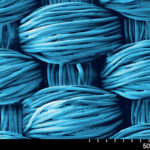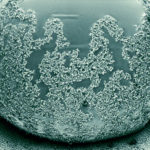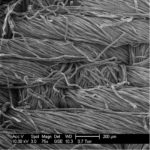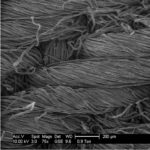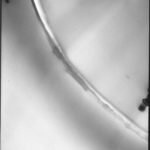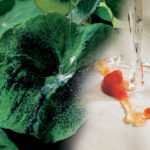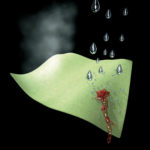Molecular manipulation to change the textile industry
Would you like to have shirts that don’t get dirty? What if the milk that spilled in your minivan never smelled? Wouldn’t it be convenient if the seats in your boat couldn’t mildew? And imagine the value of a surgical mask that actually kills germs, rather than simply preventing them from being inhaled. As futuristic as this all seems, it’s here now, the result of a technology focused on a piece of matter one billionth of a meter in size—the tiny nano.
The premise is delightfully simple in concept: manipulate particles at the molecular level to enhance the performance of a fabric without compromising the fabric’s original properties—durability, softness, flexibility, and so on. In practice, putting these premises into commercial play can require nothing less than breakthrough science.
Nanotechnology enhances fabrics
Some nanotechnology and processes are proprietary, and some are not; the nature of the technology varies, but regardless of the specifics, few call it “coating.” Some producers might refer to it as finishing, but it is, more accurately, enhancing the fabric. Traditional coatings change the natural characteristics of the fabric; at the nano level, the enhancement actually becomes part of the fabric.
According to Mark Brutten, senior vice president of marketing at Nano-Tex, Oakland, Calif., three steps define nanotechnology:
1. A portion of what you are working on is at the nano scale.
2. Your work incorporates the principle of ordered assembly; that is, you are able to manipulate and organize the particles in a purposeful and controlled fashion.
3. The end result is that you have created novel properties—a benefit or functionality that is unique.
The end result could be a fabric that repels dirt, stains or water—or one that makes rayon hydrophilic (moisture absorbent). It could even be fabrics that are self-cleaning, that resist radiation and chemical damage, or that kill germs and prevent the spread of infection. Key to the technology is the concept of “value added”—fabrics that offer a variety of desirable properties in addition to the basic qualities of the fabric itself, as more and more consumers and end-users demand more and more performance in addition to utility and style.
- At first sight, polyester fabric finished with Mincor TX TT looks unchanged (Electron Micrograph 500 ). Photo: BASF Group.
- Mincor from BASF emulates nature as shown in the self-cleaning effect of a water droplet on the leaf of the Taro plant. Photo: BASF Group.
Nanocide™ Antimicrobial kills germs on upholstered surfaces
“Yes, we think we have the wonder product,” says Mike Jobe, vice president of sales and marketing for CMI Enterprises, Miami, Fla. The company’s Nanocide™ Antimicrobial has been proven, he says, to combat infections by killing germs on upholstered furniture and other objects in as little as 30 minutes, and claims a kill rate of 99.9 percent against resistant staphylococcus germs. That means that any location where germs can be transferred, exposure to dangerous infections can be drastically reduced with enhanced upholstery products.
Using principles of electricity, the technology makes the surface of the upholstery deadly to germs, even the “superbugs” that have become resistant to many antimicrobial products.
“It works like getting hit by a lightning bolt. It breaks the cell wall open and kills the germ,” Jobe says.
Although Nanocide uses silver oxide (a substance that was known for its germicidal properties even to the ancient world), Jobe says their patented process goes far beyond the more familiar—and less stable—silver-based coating processes, which wear off over time and can release fugitive nanoparticles into the environment.
“Ours is pure silver oxide that we imbed permanently into the surface, and it doesn’t come out,” he says.
Nanosilver used in other coatings would be about 80 nanometers, compared to Nanocide’s four to six nanometers.
“That’s infinitesimally small,” Jobe says. “Because it’s so small, it increases the surface area for a germ to fall on, and the smaller it is, the more efficient it is for killing germs.”
CMI Enterprises sells the silver technology in addition to the enhanced fabric, opening up an entire range of textile applications.
Nanotechnology offers multiple methods for killing germs
LaamScience, Raleigh, N.C., takes its name from the nanotechnology it developed—light-activated antimicrobials—and touts a mission with a superhero flair: “to stop pandemic disease and death by integrating light-activated antiviral and antibacterial coatings into everyday products throughout our lives.” The company also has the goods to back it up. Stephen Michielsen, associate professor in the Department of Textile and Apparel Technology and Management at North Carolina State University, and coinventor of the technology, says the light-activated material acts in a matter of seconds to kill viruses and bacteria.
“Using dyes that are commercially available, the nano-sized substance is attached to the surface of the fibers in a very thin layer. When they absorb the light, they transfer it over to the air. We turn air toxic to microbes, but not to people,” Michielsen says.
The company is anticipating Federal Drug Administration (FDA) approval late in 2008 for its first product, an air filtration mask. The mask would not only prevent the person wearing it from inhaling germs and viruses, the mask itself would kill germs and viruses, thereby preventing contamination from handling or disposing of the mask.
“It’s not science fiction. We could take a pandemic and reduce it down to a normal flu season,” he says.
But this is just the beginning.
“We expect to be able to treat virtually any type of fabric that is exposed to light,” Michielsen says.
Further, just about any available light would do, from natural sunlight to the lamp in your living room. Michielsen could not divulge the specific material used in his light-activated product, for proprietary reasons, but he did note that it can be compared to the means used by Mother Nature to clean a river.
Nano-improved fabrics fulfill various industry needs
While fighting the spread of infection is surely a worthy aim in an increasingly crowded world, nano-improved fabrics are capable of much more. Nano-Tex, for example, offers six products primarily for garments, but some, such as Resists Spills, are highly desirable for commercial spaces, as well as recreational vehicles and boats. This product causes liquids to bead up and roll off the surface. Another offering from the company, called Neutralizer, eliminates body odor by trapping odor particles that are not released until the garment is washed.
- Nano-Tex treated fibers magnified 1,000 times appear to be no different than untreated fibers. Photo: Nano-Tex.
- Only at Nano-Scale Photography can the enhancement of the fiber be discerned. The cross section of the fiber has been mounted in an epoxy to contain it. The fiber is on the right, and the curved shadow represents the Nano-Tex enhancement. Photo: Nano-Tex.
Mincor® TX TT, from BASF in Germany, was also developed for self-cleaning textiles. Yoko Koike, with the Global Business Unit, Leather and Textile Chemicals for BASF, says they use a formulation comprised of binder, nanoparticles and fluorocarbons. This makes the fabric more repellent to soil than standard finishes.
“The nanoparticles are firmly imbedded in the binder, producing an extremely structured surface,” Koike says. “The self-cleaning finish results in a more-or-less instant wash when it rains, and therefore offers protection against mildew stains and permanent soiling. In addition, the surface of the fabric is always dry.”
Nano-enchanced clothing protects troops
Characteristics that conjure up visions of 1950s era space suits aside, there are products with more mundane, but certainly still worthy, goals. As much as any of us anywhere can appreciate the convenience of clothes that repel dirt and stains, this property can be invaluable where comfort and performance aren’t so easy to come by but can be far more important, such as for the troops in the field.
Although NanoSphere®, developed by Schoeller Technologies, Sevelen, Switzerland, “existed long before,” Duro Textiles, Fall River, Mass., more recently obtained the license for it in the United States, says Dawn Clarke, vice president of technical and military marketing.
“Our specific target was to bring this to the U.S. military; bring what is the best technology in the world to the U.S. troops,” Clarke says.
“A textile treated with NanoSphere offers a very high level of water repellency without influencing the breathability,” says Hans Kohn, chief operating officer at Schoeller Technologies. “Therefore, garments with NanoSphere need less frequent washing and can be washed at lower temperatures. The finish can be reactivated, for the entire life of the garment, by ironing or tumble drying.”
- Nanosphere, a product of Schoeller Technologies, causes liquids to bead up and roll off the surface of the textile. Photos: Schoeller Technologies.
Enhanced performance that lasts the life of the fabric is the calling card for this technology. But does this mean prohibitive expense for the customer? Not necessarily. According to Brutten at Nano-Tex, one has to look at the total cost of ownership. For example, if a hotel would routinely reupholster or buy new furniture every three years, why not buy a product that lasts three times longer (as an estimate), even though it costs more up front? “Never mind performance that just didn’t exist before,” Brutten says.
Nanotechnology shows high growth potential
Web sites that share information on nanotechnology are offering staggering figures concerning growth potential in the industry. Nanoposts.com forecasts that nano-based products and processes will be worth $4.9 billion to the textile industry by 2015, and that 24.6 percent of all textile products available in 2015 will incorporate some form of nanotechnology.
Brutten believes that nanotechnology will impact virtually every business in the future. “The pace of innovation is stepping up. With each new invention, the more futuristic inventions become attainable,” he says.
Janet Preus is a freelance writer and editor based in St. Paul, Minn.










